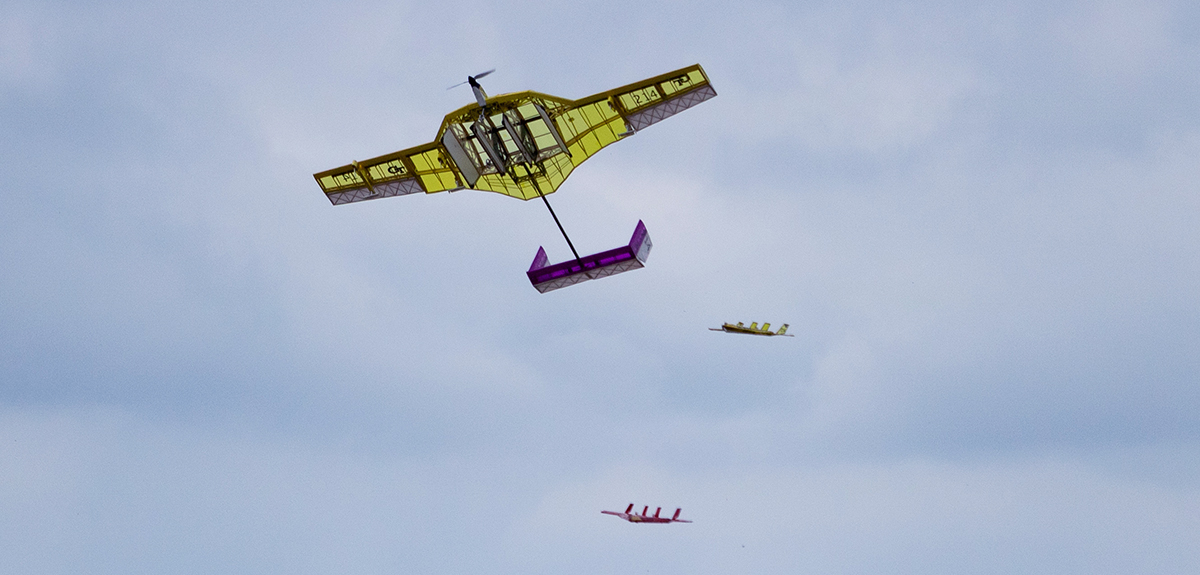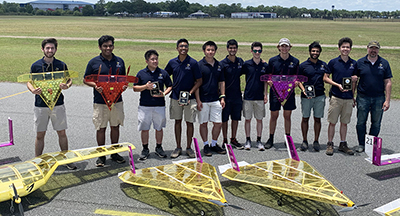 Gliders and Fliers. AmaBUZZ Prime and NimBuzz 2000 won big at the 2021 SAE Aero East Design Competition.
Gliders and Fliers. AmaBUZZ Prime and NimBuzz 2000 won big at the 2021 SAE Aero East Design Competition.
Undergraduates from the AE School’s Design Build Fly team took home the top prize for their entries in the Society of Automotive Engineers (SAE) Aero Design East collegiate competition, held June 4-6 in Lakeland, Florida.
The two uncrewed aerial vehicles - AmaBUZZ Prime and Nimbuzz 2000 - each received the Best Design Report, Best Mission Performance, and Best Overall for their entries in the Micro and Advanced Class competition. Nimbuzz 2000 received an additional award for Best Presentation.
“I'm very proud of the team's hard work and dedication. We've been very successful, but every year it is a struggle. This year had some unique challenges and they were able to adapt and learn valuable lessons from the experience,” said DBF faculty advisor and research engineering Carl Johnson.
 |
| AmaBUZZ Prime takes flight after a short takeoff |
Gowtham Venkatachalam led the Georgia Tech team in the Micro Class division which received three first-place awards for design report, mission performance, and overall. The Micro Class challenged teams to design a small, lightweight, all electric aircraft to complete a variety of conflicting design and performance requirements to mimic a take-off from an aircraft carrier.
“For this year’s competition it was more of an acceleration challenge. After a table takeoff we had to fly 300-feet as fast as possible while carrying as many pizza boxes and steel plates as possible,” explained Venkatachalam.
The pizza boxes were a unique challenge for the teams and made them engineer different ways to handle accelerating with a bulky payload.
“We decided to design AmaBUZZ Prime to have a centered delta-wing and a four-foot wingspan to give us the velocity to maximize our speed right after takeoff,” said Venkatachalam.
Even though this year was different than past competitions, the lessons were still there. The Georgia Tech team spent most weekends conducting flight tests and making adjustments, so they learned the hard lessons there and not during the competition. They were able to work together for the entire year without a single case of Covid-19 and that’s something Venkatachalam credits to Georgia Tech’s on-campus surveillance testing.
“The biggest difference this year, because of the pandemic, was that we worked in smaller sub-groups of five people and had more virtual meetings and advisement throughout the process,” said Venkatachalam.
Their hard work paid off and is not over. Venkatachalam looks forward to returning to his DBF roots as the club’s new President in the Fall where he will begin his master’s degree under the guidance of Regents Professor Dimitri Mavris.
 |
| NimBuzz 2000 drops off its payload of Nerf footballs during the SAE competition |
Mark Lau and co-chief engineers Jude Augustine and Pranav Krishnamurthy led the Georgia Tech team in the Advanced Class which received four, first-place awards for design report, presentation, mission performance, and overall.
“This was our third year with this rule set, so we’ve had two years to evolve the design and continuously approve upon it each year,” said Lau.
The objective of this year’s Advanced Class was to design a vehicle that can mimic a settlement mission to deliver colonists, habitats, and supplies safely to the surface of Mars.
The winning aircraft - NimBuzz 2000 - weighed 34 pounds, had an 11-foot wingspan, and a payload that included ping pong balls (colonists), Nerf footballs (habitats), water bottles (supplies), and three colonist delivery aircraft (autonomous gliders).
Not only is the aircraft design complex, but the mission itself requires good communication skills between the pilots and ground control to make sure their payloads hit a target with a fifty-foot radius.
“Each flight round we had to adjust our payloads because our scores are a function of not just how much of everything we deliver, but a function of balance,”
The team had a flight round where they delivered an off-balance ratio of colonists (ping pong balls) compared to the amount of water and habitats needed to optimize their score, so they made the necessary adjustments for their remaining flights to get the highest score possible.
 |
| The Micro and Advanced Class team were all smiles on competition day. |
“We foresaw the problem in the aircraft design phase, so we designed extra space in our payload bays for this flexibility,” explained Lau. “We had to rapidly find payload packing configurations during the competition in between flight rounds that would allow our payload to both fit securely and not shift during flight”.
Though this year’s Design, Build, Fly team was much more siloed, Lau appreciates the real-world application of managing several teams virtually and learning how to communicate effectively.
“DBF has so much focus on mentorship and ownership from every team member, whether you’re a first-year student or senior. We continuously enable each member to own and design throughout the process, and I think that type of culture is why we are so successful,” said Lau.
Lau plans on being involved with DBF next year, in a advisory role as he begins his graduate research with Daniel Guggenheim School professor Brian German and is looking forward to seeing what the new set of rules will be for the 2022 Advanced Class.
[VIDEO::https://www.youtube.com/watch?v=WAj9ff7baWw]